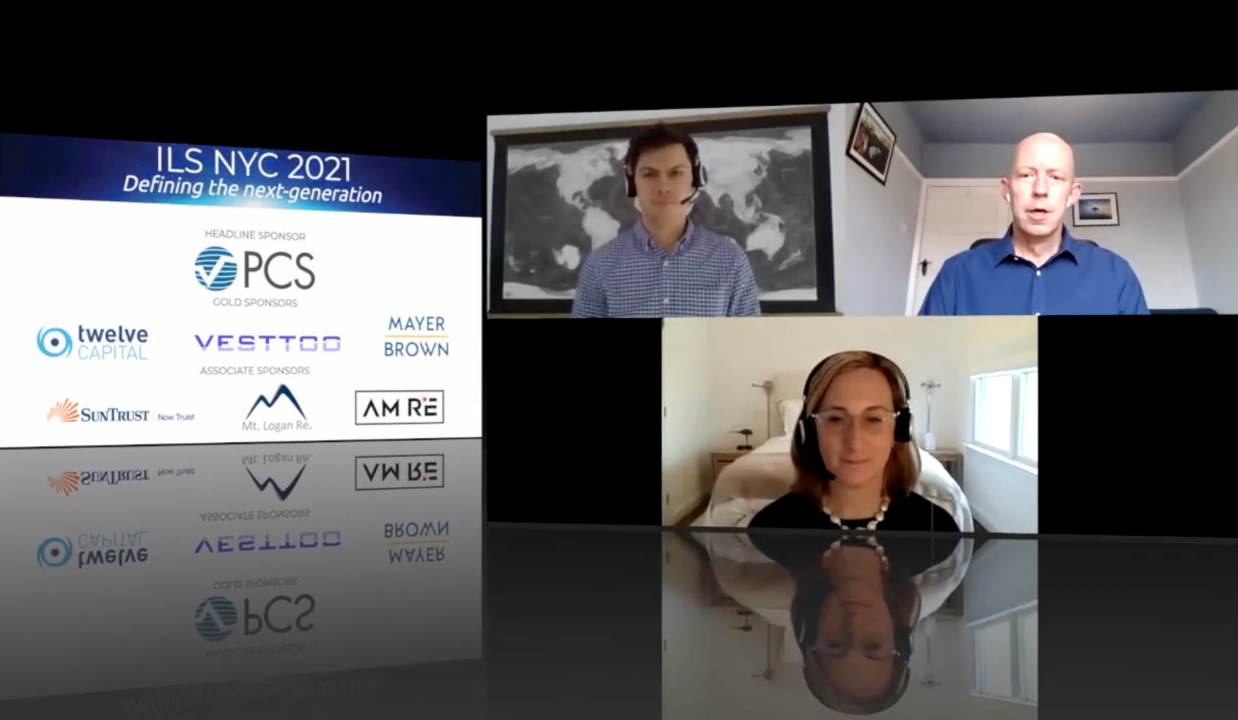At Swiss Re, alternative, or third-party reinsurance capital has become an increasing part of the reinsurance giant’s capital management strategy, and as the insurance-linked securities (ILS) asset class looks to longer-tail classes, the firm is focused on finding ways to transfer risk efficiently.
 This is according to Judy Klugman, Global Co-Head of ILS and Ed Johnson, Head of ILS Sales EMEA & APAC, both from Swiss Re Capital Markets, who featured as part of a stellar line-up of speakers at the recently held Artemis ILS NYC 2021 conference.
This is according to Judy Klugman, Global Co-Head of ILS and Ed Johnson, Head of ILS Sales EMEA & APAC, both from Swiss Re Capital Markets, who featured as part of a stellar line-up of speakers at the recently held Artemis ILS NYC 2021 conference.
Artemis’ fifth annual event in the region was the first to be held virtually and on the opening day, the audience heard from two experienced ILS market practitioners from global reinsurer Swiss Re.
“I think it’s become an increasing part of our capital management strategy, to use alternative capital,” said Johnson.
In the latter half of 2019, Swiss Re combined its ILS and retrocessional teams within one new unit named Alternative Capital Partners, which, importantly, is now part of the Group finance structure as opposed to ILS being part of the reinsurance division.
“And, so, as we look forward, we see this not just as risk management,” said Johnson. “Risk management primarily for us has meant looking at nat cat risks, but we’re thinking about how we can use the relationships we have and the capital which is invested in this marketplace, how can we use that more efficiently on the capital side as well.”
“We’re looking across the business and looking at which parts of the business consume lots of capital for Swiss Re, and thinking about how we can construct new products to help Swiss Re manage its capital needs,” he continued.
Of course, not all lines of business will be suitable for such a transaction but as stressed by Johnson, what Swiss Re is looking for are things which are really consuming a significant amount of capital across its balance sheet.
“So, for example, pandemic is obviously a very topical subject. We’ve seen that pandemic does not necessarily diversify well, even in a very diversified balance sheet. Pandemic risks correlate with asset risks, they correlate potentially with other insurance lines. So, if we can find better sources for transferring pandemic risks, then that can really help Swiss Re on its balance sheet,” explained Johnson.
Adding: “And also other longer tail lines of business. So, types of casualty risk, maybe mortality trend. These lines of business, especially now in a low interest rate environment, are using up lots of capital on Swiss Re’s balance sheet.
“And, so, our thesis is really how can we find ways to transfer those efficiently for Swiss Re and for the investor base.”
As our readers will be aware, while the remit of ILS is expanding, it remains heavily focused on the natural catastrophe arena, notably peak perils such as US wind.
After all, taking some of the peak exposure from re/insurers’ balance sheets and transferring that into the capital markets is the reason the catastrophe bond structure was established almost three decades ago. But today, there’s a growing desire from both sponsors and investors to broaden the use of ILS structures and capital into other areas of the re/insurance market, including longer-tail lines of business.
As the industry and Swiss Re explores how to unlock some of these new opportunities, Klugman offered some insights into what needs to be done to foster a broader based use of ILS capital within the reinsurance business, with a view to some of the potential stumbling blocks that might need to be addressed.
“I think back to how did we initially convince institutional investors to take a one-in-100-year probability that an earthquake was going to happen in California,” said Klugman.
“From an investor perspective, they put a price to everything, to every security they own. But they can’t price something unless they know how much risk they’re taking. And, our hallmark has always been that we never expected institutional investors to be underwriters, so to speak.
“That’s one of the features of catastrophe bonds that’s so unique compared to any other asset class out there, is that there’s a third party risk assessment and that there’s credible modelling around how to assess how much risk you’re taking so that you can price the security that you’re investing in,” she continued.
With this in mind, as the market looks to other risks and lines of business, it’s critical to consider investor comfort and understanding of the actual risk profile that they’re assuming.
“How do we get investors comfortable that the risk that they’re taking is rooted in a reality; that it’s rational? And that, to me, is not a stumbling block, but it’s something that we have to think about because we can only price something if we know how much risk we’re taking. So, that is very, very important,” said Klugman.
Importantly, Klugman reminded the audience that as we move into different lines of business, they’re not all going to be short-tail, one to two year transactions. In the cat bond marketplace, generally speaking, the majority of deals have durations of three to four years, which means you can manage the collateral very well.
“But when you go to these longer tail lines of business and you’re in this low interest rate environment, your typical collateral solution, where you just park the collateral in Treasury money market funds, isn’t really going to be a productive use.
“And, so, that’s also right now something that we very much think about, is how to come up with more efficient collateral structures…A lot of what Swiss Re is really focused on is thinking about risk transfer, along with collateral structure overlays; how do we make that combination really work,” said Klugman.
The session, which was broadcast first to event registrants on Friday 5th Feb, can now be viewed below:
Every session from ILS NYC can be viewed via our sister publications Artemis Live video channel and audio versions will also be shared via Artemis’ podcast as well.



